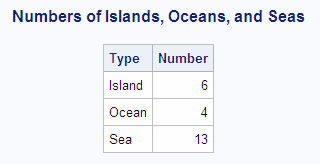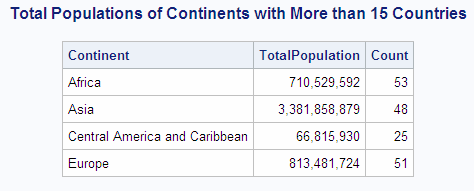Filtering Grouped Data
Using a Simple HAVING Clause
The following example groups
the features in the SQL.FEATURES table by type and then displays only
the numbers of islands, oceans, and seas:
Choosing between HAVING and WHERE
The differences between
the HAVING clause and the WHERE clause are shown in the following
table. Because you use the HAVING clause when you work with groups
of data, queries that contain a HAVING clause usually also contain
the following:
Note: If you use a HAVING clause without
a GROUP BY clause and if the query references
at least one aggregate function, PROC SQL treats the input data as
if it all comes from
a single group of data.
Using HAVING with Aggregate Functions
libname sql 'SAS-library';
proc sql;
title 'Total Populations of Continents with More than 15 Countries';
select Continent,
sum(Population) as TotalPopulation format=comma16.,
count(*) as Count
from sql.countries
group by Continent
having count(*) gt 15
order by Continent;Copyright © SAS Institute Inc. All rights reserved.

